
|
 |

|
|---|
OUT OF BAKERSFIELD, CALIFORNIA
THE WONDERFUL Mr. D.C. PARKS:
For those of you who do not know about this guy, Mr. Parks was quite a character in his day. And given the fact that most of his works were published back in the late 1960’s, one can think of him as being among the “Last of the hard-core Reefer Madness Cases”. According to one of his book covers:
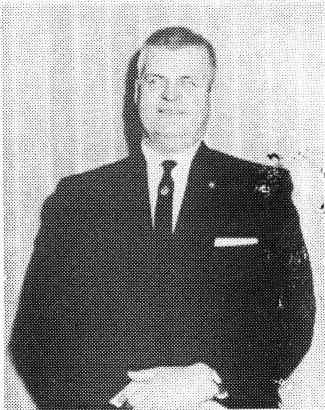
Although D.C. Parks has been blind for nearly twenty seven years, he has never allowed this handicap to interfer(sic) with a full, rewarding life and a distinguished business career. Although he is now retired from active participation in farming, he was for many years an award-winning rancher near Bakersfield, California, where he continues to make his home. He has long been active in politics as a concerned citizen and has published numerous articles on narcotics and politics. He remains consistant(sic) as a philanthropist; all the net returns from this book will be used to fight the narcotic, dope and drug abuse problem. CARLTON PRESS – NEW YORK
MAYBE it would be best to go over one of his works: The following bits and pieces are taken directly from one of his books:
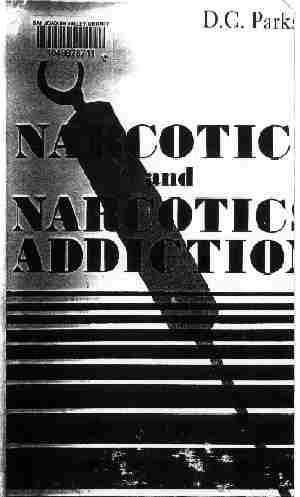
Narcotics and Narcotics Addiction
by D.C. Parks (1969)
Cannabis-Hemp-Marijuana Is Identified
. . . Marijuana is a brain-numbing narcotic drug, causing an individual to commit crime without fear or a guilt complex. He will also commit atrocities to himself or others.
Marijuana is the only drug known to man that will contract one eye, and dilate the other in the same body at the same time, showing complete distortion of one-half the brain.
Can you imagine the predicament an individual would find himself in with his vision obstructed in this manner?
Many people have made the statement, others are still making statements that, "Marijuana is a new drug. We do not know much about it. We should take it easy and go slow."
Marijuana dates back three thousand years B. C.
Dope pushers have revealed to me why some young people do not get any results from smoking marijuana. They said the reason is that pushers of drugs become short of money; their credit is no good, so they sell these young people black tea for marijuana. They say it looks and tastes the same. The smoke also smells like marijuana.
The effect that marijuana has on an individual is measured by the strength of the marijuana used. This is measured by the amount of resin that is produced by a given plant. Example: Anything diluted to the extent that it cannot be identified will have little effect on the human body and mind. Example: One teaspoon of alcohol in ten gallons of water would have no effect on an individual's actions. In fact, the person could drink alcohol in this form forever and never become intoxicated. One ounce of marijuana mixed with one hundred pounds of tobacco would have no damaging effects to an individual.
MARIJUANA SMOKING AND ITS EFFECTS
How marijuana is smoked to receive its maximum thrills or depressants: Group smoking is the practiced method. People sit around a table. They place the cigarette in their mouth with their hands cupped in front of the cigarette to preserve all the smoke. They draw through the cigarette and also take in air from the outside, sucking the smoke deeply into their lungs, hold it as long as possible, then drink a cup of tea.
This method is used to retain the smoke within the lungs for the maximum length of time.
To receive a greater charge, the next step is to drink wine instead of tea. To get the maximum and full effects through smoking marijuana, alcohol is drunk instead of wine.
The smoke from marijuana smells like alfalfa burning. It makes a much brighter glow than tobacco.
The following documents were furnished by the Federal Bureau of Narcotics, Treasury Department, Washington, D. C., which they photostated from the book, THE TRAFFIC IN NARCOTICS, by Anslinger and Tompkins, published by Funk and Wagnalls, pages 22, 23, 24, and 25.
OKLAHOMA CITY, OKLAHOMA, 1943
While under the influence of marihuana, twenty-seven-year-old Carl J. M., hotel bellboy, shot and killed elderly J. S. C., guard in the Federal Building at Oklahoma City, Oklahoma. He was convicted for the crime and sentenced to serve 10 years. Another bellboy, who was arrested in the case, confessed that he and M. had smoked marihuana in a hotel room before the crime was committed. M. then left the hotel and walked to the Federal Building. On the street he met three sailors, one of whom he bit on the neck. He struck a small boy whom he met on the sidewalk. M. then went to the Federal Building and took charge of an Army Recruiting Office. When Mr. S. . . ., the building guard, was called to remove M., a fight ensued. M. seized a gun from the guard and shot and killed him instantly. M. then placed the gun on a chair and walked down the hall singing. He engaged in another fight, but was finally subdued and placed in jail. Two days later M. was still unable to think or talk coherently. He talked about trying to get on the top of an automobile where he could reach a telephone wire and swing himself to the top of the hotel and from there he could get to heaven. Later, at a hearing, M. stated that he had smoked marihuana several times; that he did not remember leaving the hotel, nor the fights nor the shooting of Mr. S .... ; he did not remember his arraignment and stated the first he knew about the matter was after he came out of the stupor when someone told him he had shot and killed a guard at the Federal Building. M.'s employers stated he had always been quiet and sober, and had never caused trouble of any kind.
CLARKSBURG, WEST VIRGINIA, 1937
Lewis H., twenty-six years of age, arrested for rape of nine-year-old girl while under the influence of marihuana.
BALTIMORE, MARYLAND, 1936
The chief engineer of a vessel arriving at Baltimore complained to the Federal narcotic office that the crew of his vessel were using some unknown narcotic that was so virulent in its effects on the men that the officers were obliged to protect themselves by carrying blackjacks to ward off attacks. The narcotic agent ascertained that a fireman, aged twenty-two, was a marihuana user, and that two of the seamen on the ship had purchased a bag of dried marijuana while ashore in the Canal Zone and smuggled it aboard ship, where it was consumed by members of the crew. Officers of the steamship said these men were "under the influence of this narcotic throughout the trip to Baltimore and that their conduct bordered on the mutinous."
CLEVELAND, OHIO, 1948
James B., who was arrested by police for the murder of a sixty-year-old widow, admitted that he and an accomplice had participated in brutal attacks on sixteen women for the purpose of robbing them of their money. He said he wanted the money to buy wine and reefers which he consumed at the same time.
Before committing their atrocious crimes, B. and his accomplice always fortified themselves with wine and marihuana.
SPOKANE, WASHINGTON, 1940
Joseph M., shortly after having smoked two marihuana cigarettes, brutally murdered a seventy-four-year-old retired railroad worker. According to testimony brought out at his trial for manslaughter, M. had never before seen his victim and could assign no reason for having murdered him other than that following the smoking of the marihuana cigarettes he had become obsessed with an idea that he was being pursued and upon encountering the aged man he attacked and killed him. M. was sentenced in October, 1940, to serve twenty years in the Washington State Penitentiary.
DEL RIO, TEXAS, 1940
One Eleutero G. while allegedly under the influence of marihuana, shot to death two women and then committed suicide by literally slicing himself to bits about the abdomen, heart, and throat, in a manner which indicated that he was bereft of all reasoning. Law enforcement officers believed that G. was under the influence of marihuana at the time of the double murder and suicide and that he had previously used marihuana. It was the opinion of the doctor who saw G. just before he died that no one could so mutilate himself unless he was unable to feel "shock" and the only thing he knew that would produce such a condition, to such a degree, is marihuana. G. had wandered around in the fields for hours after the killing and after his self-mutilation.
Investigating a disturbance in a cafe in a southern Ohio city, police officers saw Anthony E. pointing a loaded revolver at patrons. E. resisted arrest, and after a severe struggle the officers subdued him. Earlier, E., with the use of his revolver, had robbed Abe L., driver for the W. Bakery Co., of $5.00. At the time of the arrest, the defendant was completely under the influence of marihuana and a quantity of marihuana was found in his possession.
On a Saturday evening in November, 1945, a pretty seventeen-month-old baby girl was left in the family car while her parents went in search of a relative. When they returned to the car less than ten minutes later, the baby had disappeared. The next afternoon, scarcely 200 yards away, the body was found in the furrow of a cotton field. The baby was naked except for one small white shoe and a red-knitted bonnet. She had been violated. Teeth marks covered her body. Her tiny contorted face had been shoved into the mud and particles of dirt in her lungs showed that she had been alive at the time and suffocated later.
Police arrested a twenty-five-year-old cotton picker, Paul G., who readily admitted kidnapping the child and "spanking her a little bit." G. stated that on the Saturday evening in question he had been drinking when a friend offered him a reefer which he accepted and smoked. Further intoxicants followed. Then G. went to a dance hall, from which he departed because no one would dance with him in his condition. As he left, he heard the child crying in a car. Annoyed, he picked up the infant and spanked her, but remembers nothing further except he "guesses he just went crazy." His next recollection was when he came to in his cabin the following morning with mud and blood on his clothes.
For what the district attorney described as "the most horrible, the most brutal crime in the history of the area," Paul G. was sentenced to death. The final words of his counsel are well worth remembering: "The real criminal in this case is marihuana!”
On January 10, 194-, Robert F. assaulted Mrs. Mildred Y., stole a gun, and held up his former employer. On January 15, he entered a salesman's car while it was stopped in traffic, and when the salesman didn't follow directions, shot him in the stomach. On January 21, he broke into a home, stole some money, and beat a seventy-eight-year-old woman severely. On January 22, he entered a cleaning shop, attempted to rape the clerk, and stole $75. An aroused police force tracked him down, and cornered him. F. shot one officer and then seeing that he was trapped, shot himself. Each of these crimes was attributed to marihuana intoxication.
One summer evening Moses M. bought his first two marihuana cigarettes for twenty-five cents each. After smoking them, he said, "I felt just like I was flying." Moses, crazed with marihuana, went through the window of his hotel room, dropped eighteen feet to the roof of the garage next door in his bare feet, and then went through the window of K.'s room crying, "God told me to kill this man." Seizing K. by the throat, Moses beat him to death with his fists after which he broke a chair over his victim's head. Then screaming that he was pursued by Hitler, Moses went out through the window, and dropped his two hundred pound frame to the alley thirty feet below. In court Moses had no recollection of the killing and asserted, "I didn't want to hurt him." "Twenty years," said the court.
The above documented evidence should be conclusive whether the use of marijuana is dangerous. It also should prove that the law, penalties, and prosecution should not be altered.
MARIJUANA IS ADDICTING
The first thing that must be understood: What is addiction? Following are definitions of addiction from Webster's Third New International Dictionary, unabridged, pertaining to those things that are harmful to the human mind and body.
ADDICTION: 1. Inclination bent. 2. The quality or state of being addicted; specifically: the compulsive uncontrolled use of habit forming drugs beyond the period of medical need or under conditions harmful to society: Example: the extent of addiction ranged from 2 months to 10 years. 3. Enthusiastic devotion, strong inclination, or frequent indulgence. Example: his addiction to the comics; his addiction to vivid metaphors.
ADDICTIVE: Causing or characterized by addiction.
ADDICTED: Devoted or given up, examples: Addicted to wine; addicted to stealing. Strongly disposed or inclined, example: addicted to reading mystery novels; easygoing as a husband.... straightforward as a politician, and as a man, addicted to pleasure-John Galsworthy.
1 ADDICT: To award or deliver by judicial degree-used in works on Roman law. b: to give over: give up: surrender. c: to attach (oneself) as a follower to a person or adherent to a cause (we sincerely addict ourselves to Almighty God-Thomas Fuller) 2: to apply or devote (as oneself or one's mind) habitually: give (oneself) up or surrender (oneself) as a constant practice: Habituate, devote the researches to which your taste addicts you Sir Walter Scott: such persons . . . will addict themselves to history or science-J. S. Mill. To forswear thin potations and to addict themselves to sack-Shak. 3. To cause or induce (a person) to make habitual use of a drug (addicts ... find it convenient to addict several other persons-D. W. Maurer & V. H. Vogel) addict vi, of a drug: to bring about or cause habitual use (drugs . . . threaten us because they are addicting-D. W. Maurer & V. H. Vogel).I have discussed addiction with many doctors. The common understandable conclusion among them is that if you are a doctor you would use the word addiction. If you are a lay person you would use the word habit. This does not separate the two words very far apart, so we must draw the conclusion that habit and addiction are very closely related.
2 ADDICT: One who is addicted to a habit; specifically: one who habitually uses and has an uncontrollable craving for an addicting drug (a morphine addict) (a barbiturate addict) 2: One showing zealous interest (as in a sport or pastime): an enthusiastic devotee (he has been a baseball addict since boyhood).
Some people have made the statement that one drug or narcotic is not as addictive as the other. The explanation is whether it causes a withdrawal syndrome period or illness, showing visual effects.
Other people claim that some drugs are addictive to the mind or nervous system referred to as psychological addiction. Whether it is psychological or physical they cannot be separated to a great degree. They are also closely related because hypertension can be prevalent in the body for a long period of time without showing effects, but the buildup is there. To be physically ill for a long period of time has a psychological effect on the mental and nervous system.
The book, THE UNITED NATIONS AND NARCOTIC DRUGS, on page 19, refers to cannabis, or the resin from the marijuana plant as a "narcotic drug." "In many countries, however, the abuse of cannabis gives rise to a problem, not only because it is in itself dangerous but also because it only too frequently leads to very much more serious drug addiction, particularly to heroin addiction (as in the United States)." . . . .
. . . EFFECTS
The narcotic drug processed from the marijuana plant is a brain-numbing drug. An individual under the influence of marijuana would see children crossing the street to catch the school bus. These children would appear four blocks down the street. They were only one-half block away.
LOSS OF MEMORY
It has been reported that individuals under the influence of marijuana have forgotten their own name, the state or city in which they live, along with their street and house address. When an individual loses his identity it is hard to find his way home.
The following was taken from an article entitled, CURRENT ISSUES IN THE PREVENTION AND CONTROL OF MARIHUANA ABUSE, by Gene R. Haislip, L.L.B. L.L.M., Attorney Advisor, U. S. Bureau of Narcotics.
"The active principles of the cannabis plant are drug substances called tetrahydrocannabinols. They have been extracted from the plant resins by scientists and found to be highly potent. Informed scientists have stated that marihuana is capable of producing all of the effects of LSD which is conceded to be one of the most powerful drugs known to man. The strength of any given preparation of marihuana depends upon the amount of tetrahydrocannabinol which is contained in it. This may vary greatly from preparation to preparation."
This should suffice that LSD and marijuana should carry the same classification as far as law is concerned. The felony should remain with marijuana and LSD should carry the same classification and penalties.
"Among the more prominent subjective effects of cannabis ... are: hilarity . . . carelessness; loquacious euphoria . . . distortion of sensation and perception . . . impairment of judgment and memory; distortion of emotional responsiveness; irritability, and confusion. Other effects, which appear after repeated administration . . . include: lowering of the sensory threshold, especially for optical and acoustical stimuli ... illusions, and delusions that predispose to anti-social behavior; anxiety and aggressiveness as a possible result of various intellectual and sensory derangements; and sleep disturbances.
"The immediate physical effects of marihuana intoxication include a loss of coordination, an abnormal lowering of the body temperature and inflammation of the mucous membranes of the mouth, throat and lungs. However, the damage to the body becomes much more apparent in the chronic marihuana smoker:
"Excessive dosage of these drugs repeated daily upsets the alimentary and excretory systems. Appetite declines and food is not properly assimilated. The addict may lose weight rapidly and may suffer from general cachexis (wasting away); the skin becomes pale and dry and is often covered with scales; the nails and the teeth decay and the hair, which is frequently affected, becomes dry and loses its lustre."
From a medical standpoint the distinction between addiction and dependence cannot be overlooked, but it assumes only minor importance when considering the practical social dangers of the drug. Dr. David Ausubel found that chronic users of marihuana will go to great lengths to insure that they will not be without the drug. Deprivation, he says, may result in "anxiety restlessness, irritability, or even a state of depression with suicidal fantasies, sometimes self-mutilating actions or actual suicidal attempts." Dr. Chapple in England also observed that from a psychiatric point of view, marihuana dependence is but little different from narcotic addiction.
"Acute mental derangements due to cannabis drugs are marked by extreme vehemence of the mania. Mental, moral and muscular manifestations are more pronounced, and differ from those seen in the case of alcohol and other drugs. The individual looks confused and excited.... He shouts, voraciously, sighs, walks quickly up and down or round his cell. If at liberty, he is violent, aggressive, and may run amuck . . (definition of amuck: furious attack, charge. A Malay that goes into a murderous frenzy and attacks people at random. A murderous frenzy that occurs chiefly among Malays. An inflexible, confined, and unpermissive environment is the essence of amuck. J. M. Van der Kroef. In a murderously frenzied manner. In a violently raging manner. In an undisciplined manner. Needlessly. Possessed with a murderous or violently uncontrollable frenzy) Instances are on record where the patient in this state of excitement got hold of a weapon and committed murder without any provocation."
. . . . ACTION AND USES
"Cerebral stimulant, analgesic, narcotic, . . . Used as a sedative in migraine, neuralgia, hysteria, cramps of summer diarrhea, spasmodic cough and in preparations for intestinal disorders. Cannabis acts upon the central nervous system, especially the higher psychic centers, producing mental excitement and exhilaration. In large doses it produces delirium with hallucinations followed by sleep interrupted by dreams, marked weakness and mental depression." . . .[more]
NOTE the museum has (courtesy of the Kern County (Bakersfield, Ca.) Public Library) been able to obtain a few of his pamphlets. If needed feel free to contact the museum.
IN a way it’s a pity, had this been 1935 instead of 1969 he might have been a welcome sight. HOWEVER, according to communications (memo’s, internal letters, etc.), at this point in time, not even the Federal Bureau of Narcotics, wanted much to do with him. And it seems that a lot of other people also felt the same way. After all (from a narc’s perspective), it appears that all he was doing was inadvertently stirring up a lot of old dirty laundry about the origin of the anti-Medical Cannabis laws. Something that everyone at the DEA now wanted long ago forgotten.
The following communications were taken from Bureau of Narcotics files found via the National Archives.
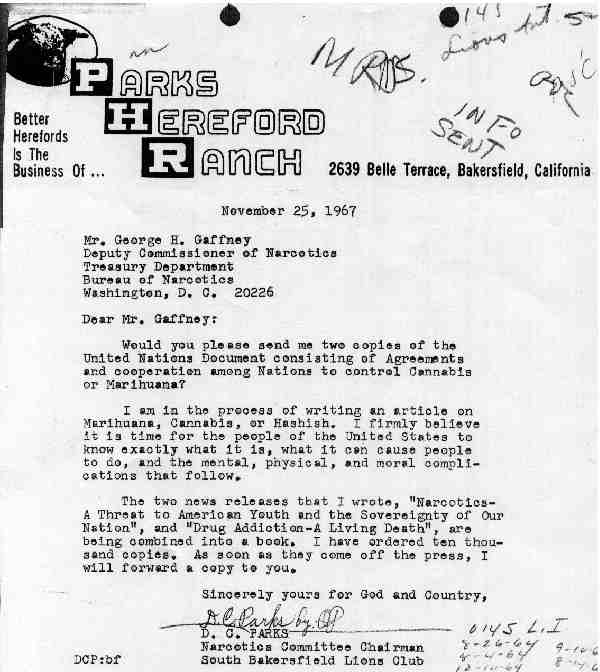
Better Herefords Is The Business Of
PARKS HEREFORD RANCH - 2639 Belle Terrace, Bakersfield, California
November 25, 1967
Mr. George H. Gaffney
Deputy Commissioner of Narcotics Treasury Department
Bureau of Narcotics
Washington, D. C. 20226
Dear Mr. Gaffney
Would you please send me two copies of the United Nations Document consisting of Agreements and cooperation among Nations to control Cannabis or Marihuana?
I am in the process of writing an article on Marihuana, Cannabis, or Hashish. I firmly believe it is time for the people of the United States to know exactly what it is, what it can cause people to do, and the mental, physical, and moral complications that follow.
The two news releases that I wrote, "Narcotics ---A Threat to American Youth and the Sovereignty of Our Nation ", and “Drug Addiction-A Living Death", are being combined into a book. I have ordered ten thousand copies. As soon as they come off the press, I will forward a copy to you.
Sincerely yours for God and Country,
(singed) D.C. PARKS
Narcotics Committee Chairman
South Bakersfield Lions Club
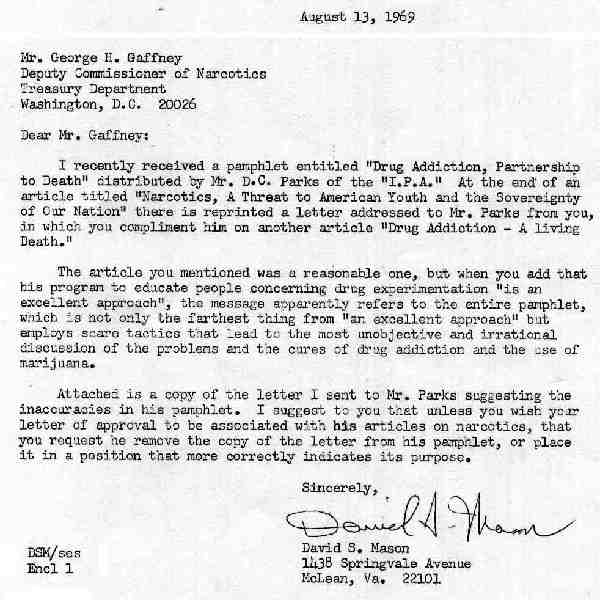
August 13, 1969
Mr. George H. Gaffney
Deputy Commissioner of Narcotics
Treasury Department
Washington, D.C. 20026
I recently received a pamphlet entitled “Drug Addiction, Partnership to Death” distributed by Mr. D.C. Parks of the “I.P.A.” At the end of an article titled “Narcotics, A Threat to American Youth and the Sovereignty of Our Nation” there is reprinted a letter addressed to Mr. Parks from you, in which you compliment him on another article “Drug Addiction --- A living Death.”
The article you mentioned was a reasonable one, but when you add that his program to educate people concerning drug experimentation "is an excellent approach”, the message apparently refers to the entire pamphlet, which is not only the farthest thing from “an excellent approach" but employs scare tactics that lead to the most unobjective and irrational discussion of the problems and the cures of drug addiction and the use of marijuana.
Attached is a copy of the letter I sent to Mr. Parks suggesting the inaccuracies in his pamphlet. I suggest to you that unless you wish your letter of approval to be associated with his articles on narcotics, that you request he remove the copy of the letter from his pamphlet, or place it in a position that more correctly indicates its purpose.
Sincerely,
(singed)
David S. Mason
1438 Springvale Avenue
McLean, Va. 22101
DSM/ses Encl 1
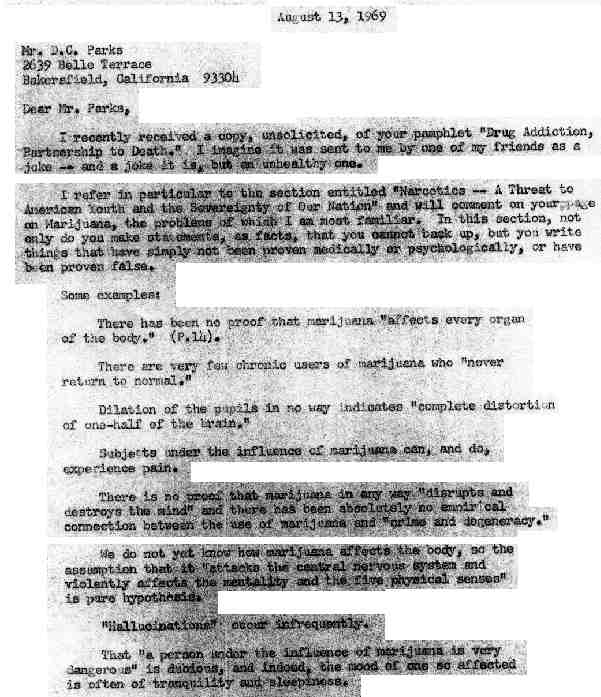
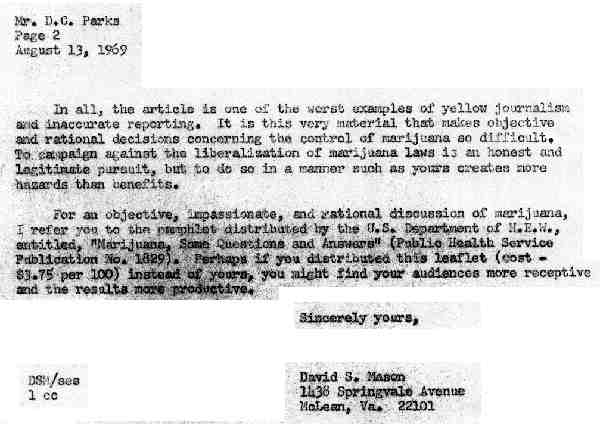
August 13, 1969
Mr. D.C. Parks
2639 Belle Terrace
Bakersfield, California 93304
Dear Mr. Parks,
I recently received a copy, unsolicited, of your pamphlet “Drug Addiction, Partnership to Death.” I imagine it was sent to me by one of my friends as a joke --- and a joke it is, but an unhealthy one.
I refer in particular to the section entitled “Narcotics – A Threat to American Youth and the Sovereignty of Our Nation” and will comment on your page on Marijuana, the problems of which I am most familiar. In this section, not only do you make statements, as facts, that you cannot back up, but you write things that have simply not been proven medically or psychologically, or have been proven false.
-
Some examples:
- There has been no proof that marijuana “affects every organ of the body.” (P.14).
- There are very few chronic users of marijuana who “never return to normal.”
- Dilation of the pupils in no way indicates “complete distortion of one-half of the brain.”
- Subjects under the influence of marijuana can, and do, experience pain.
- There is no proof that marijuana in any way “disrupts and destroys the mind” and there has been absolutely no empirical connection between the use of marijuana and “crime and degeneracy.”
- We do not yet know how marijuana affects the body, so the assumption that it “attacks the central nervous system and violently affects the mentality and the five physical senses” is pure hypothesis.
- “Hallucinations” occur infrequently.
- That “a person under the influence of marijuana is very dangerous” is dubious, and indeed, the mood of one so affected is often of tranquility and sleepiness.
For an objective, impassionate, and rational discussion of marijuana, I refer you to the pamphlet distributed by the U.S. Department of H.E.W., entitled “Marijuana, Some Questions and Answers” (Public Health Service Publication No. 1829). Perhaps if you distribute this leaflet (cost - $3.75 per 100) instead of yours, you might find your audiences more receptive and the results more productive.
Sincerely yours,
David S. Mason
1438 Springvale Avenue
McLean, Va. 22101
DSM/ses

|
MORE CALIF., SICK HUMOR |
|---|
WANT TO KNOW MORE:
=====================
Due to space / download time considerations, only selected materials are displayed. If you would like to obtain more information, feel free to contact the museum. All our material is available (at cost) on CD-Rom format.
CONTACT PAGE
STATE OF CALIF.  BACK TO MAIN PAGE |